
Albite is a plagioclase feldspar mineral. It is the sodium endmember of the plagioclase solid solution series. It represents a plagioclase with less than 10% anorthite content. The pure albite endmember has the formula NaAlSi
3O
8. It is a tectosilicate. Its color is usually pure white, hence its name from Latin, albus. It is a common constituent in felsic rocks.
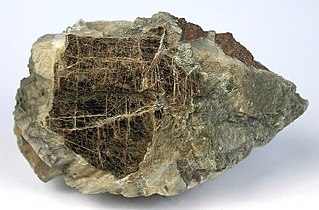
Clintonite is a calcium magnesium aluminium phyllosilicate mineral. It is a member of the margarite group of micas and the subgroup often referred to as the "brittle" micas. Clintonite has the chemical formulaCa(Mg,Al)
3(Al
3Si)O
10(OH)
2. Like other micas and chlorites, clintonite is monoclinic in crystal form and has a perfect basal cleavage parallel to the flat surface of the plates or scales. The Mohs hardness of clintonite is 6.5, and the specific gravity is 3.0 to 3.1. It occurs as variably colored, colorless, green, yellow, red, to reddish-brown masses and radial clusters.

Tephroite is the manganese endmember of the olivine group of nesosilicate minerals with the formula Mn2SiO4. A solid solution series exists between tephroite and its analogues, the group endmembers fayalite and forsterite. Divalent iron or magnesium may readily replace manganese in the olivine crystal structure.
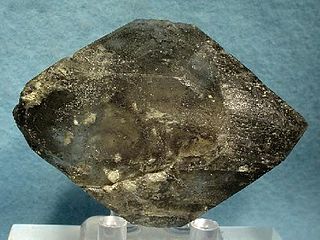
Blödite or bloedite is a hydrated sodium magnesium sulfate mineral with formula: Na2Mg(SO4)2·4H2O. The mineral is clear to yellow in color often darkened by inclusions and forms monoclinic crystals.
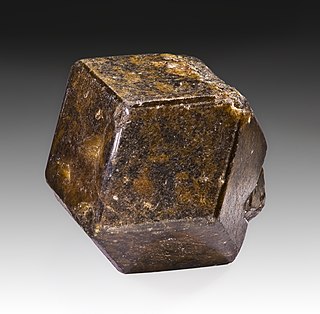
Andradite is a mineral species of the garnet group. It is a nesosilicate, with formula Ca3Fe2Si3O12.

Hausmannite is a complex oxide of manganese containing both di- and tri-valent manganese. The formula can be represented as Mn2+Mn3+2O4. It belongs to the spinel group and forms tetragonal crystals. Hausmannite is a brown to black metallic mineral with Mohs hardness of 5.5 and a specific gravity of 4.8.
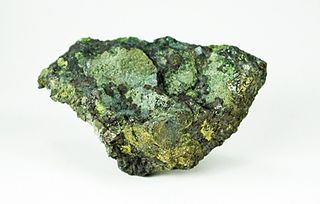
Trevorite is a rare nickel iron oxide mineral belonging to the spinel group. It has the chemical formula NiFe3+2O4. It is a black mineral with the typical spinel properties of crystallising in the cubic system, black streaked, infusible and insoluble in most acids.

Cerite is a complex silicate mineral group containing cerium, formula (Ce,La,Ca)
9(Mg,Fe3+
)(SiO
4)
6(SiO
3OH)(OH)
3. The cerium and lanthanum content varies with the Ce rich species and the La rich species. Analysis of a sample from the Mountain Pass carbonatite gave 35.05% Ce
2O
3 and 30.04% La
2O
3.

Hisingerite is an iron(III) phyllosilicate mineral with formula FeIII2Si2O5(OH)4 · 2 H2O. A black or dark brown, lustrous secondary mineral, it is formed by the weathering or hydrothermal alteration of other iron silicate and sulfide minerals.
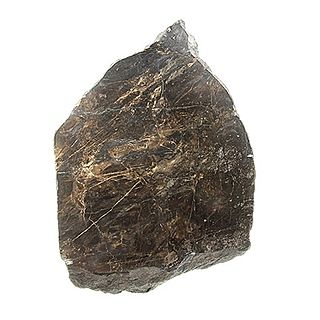
Galaxite, also known as 'mangan-spinel' is an isometric mineral belonging to the spinel group of oxides with the ideal chemical formula Mn2+Al2O4.

Jacobsite is a manganese iron oxide mineral. It is in the spinel group and forms a solid solution series with magnetite. The chemical formula is (Mn,Mg)Fe2O4 or with oxidation states and substitutions: (Mn2+,Fe2+,Mg)(Fe3+,Mn3+)2O4.

Brownmillerite is a rare oxide mineral with chemical formula Ca2(Al,Fe)2O5. It is named for Lorrin Thomas Brownmiller (1902–1990), chief chemist of the Alpha Portland Cement Company, Easton, Pennsylvania.

Botryogen is a hydrous magnesium sulfate mineral with formula: MgFe3+(SO4)2(OH)·7H2O. It is also known as quetenite.

Berlinite (aluminium phosphate, chemical formula AlPO4 or Al(PO4)) is a rare high-temperature hydrothermal or metasomatic phosphate mineral. It has the same crystal structure as quartz with a low temperature polytype isostructural with α–quartz and a high temperature polytype isostructural with β–quartz. Berlinite can vary from colorless to greyish or pale pink and has translucent crystals.
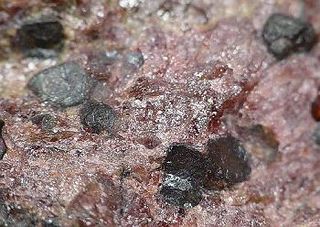
Manganosite is a rare mineral composed of manganese(II) oxide MnO. It was first described in 1817 for an occurrence in the Harz Mountains, Saxony-Anhalt, Germany. It has also been reported from Langban and Nordmark, Sweden and at Franklin Furnace, New Jersey. It also occurs in Japan, Kyrgyzstan and Burkina Faso.
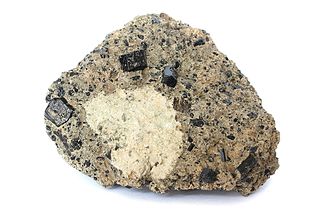
Kaersutite is a dark brown to black double chain calcic titanium bearing amphibole mineral with formula: NaCa2(Mg3Ti4+Al)(Si6Al2)O22(O)2.
Grossite is a calcium aluminium oxide mineral with formula CaAl4O7. It is a colorless to white vitreous mineral which crystallizes in the monoclinic crystal system.
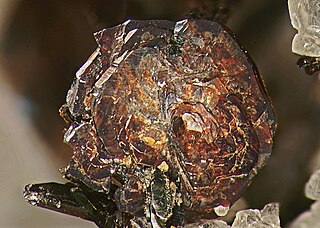
Pyrophanite is a manganese titanium oxide mineral with formula: MnTiO3. It is a member of the ilmenite group. It is a deep red to greenish black mineral which crystallizes in the trigonal system.

Ferronigerite-2N1S is an iron, tin, alumino-hydroxide mineral that naturally occurs around sillimanite-quartz veins. Ferronigerite-2N1S belongs to the nigerite group, högbomite supergroup. The other constituents of the nigerite group are ferronigerite-6N6S, magnesionigerite-2N1S, magnesionigerite-6N6S, zinconigerite-2N1S and zinconigerite-6N6S. The 2N1S ending stands for the nolanite and spinel structural layers.
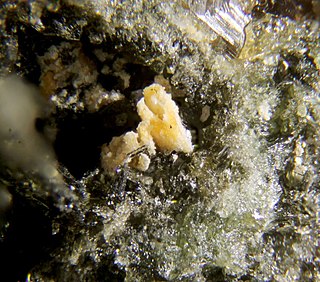
Cuspidine is a fluorine bearing calcium silicate mineral (sorosilicate) with formula: Ca4(Si2O7)(F,OH)2. Cuspidine crystallizes in the monoclinic crystal system and occurs as acicular to spear shaped pale red to light brown crystals. It is a member of the wöhlerite group.



















